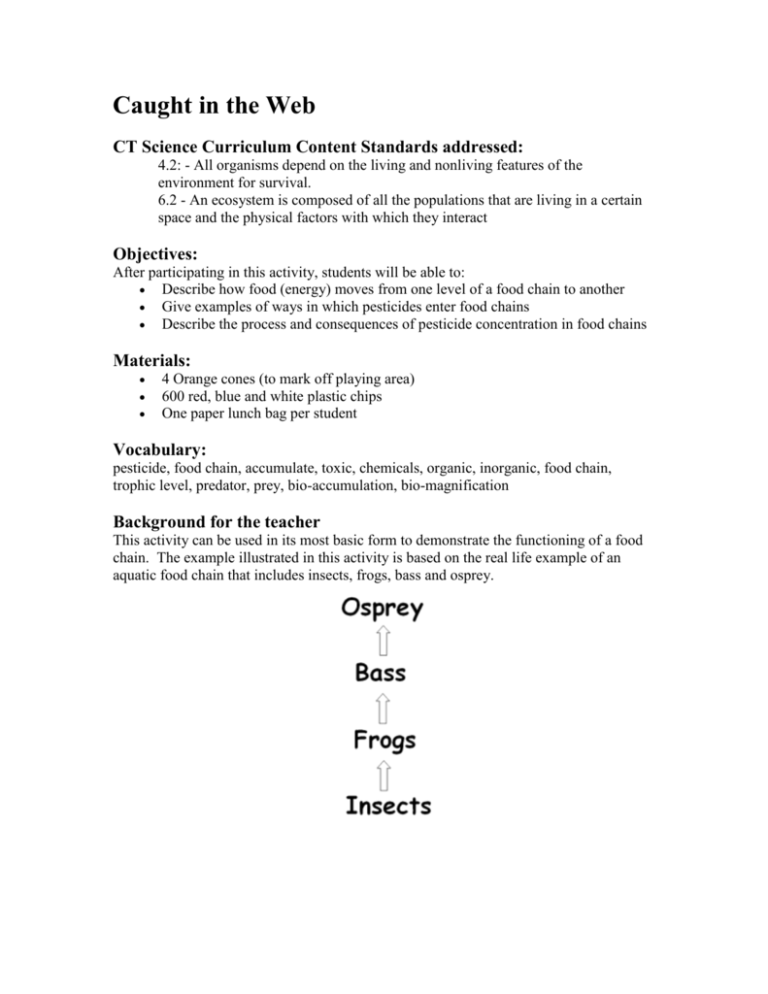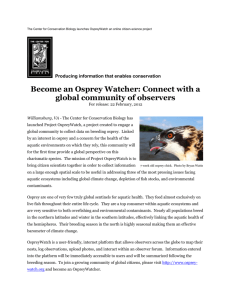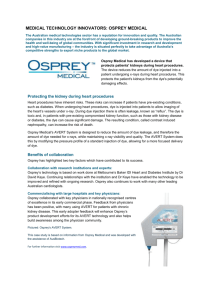Caught in the Web food chain game main document, teacher version
advertisement

Caught in the Web CT Science Curriculum Content Standards addressed: 4.2: - All organisms depend on the living and nonliving features of the environment for survival. 6.2 - An ecosystem is composed of all the populations that are living in a certain space and the physical factors with which they interact Objectives: After participating in this activity, students will be able to: Describe how food (energy) moves from one level of a food chain to another Give examples of ways in which pesticides enter food chains Describe the process and consequences of pesticide concentration in food chains Materials: 4 Orange cones (to mark off playing area) 600 red, blue and white plastic chips One paper lunch bag per student Vocabulary: pesticide, food chain, accumulate, toxic, chemicals, organic, inorganic, food chain, trophic level, predator, prey, bio-accumulation, bio-magnification Background for the teacher This activity can be used in its most basic form to demonstrate the functioning of a food chain. The example illustrated in this activity is based on the real life example of an aquatic food chain that includes insects, frogs, bass and osprey. In this example, insects provide food energy for frogs; frogs provide food energy for bass (a large predatory fish), and bass provide food energy for osprey (a bird of prey that eats fish almost exclusively). Positioned at the top of the food chain, adult osprey have no predators. The osprey has been chosen intentionally because its recent life history provides an opportunity to explore the concepts of bio-accumulation, bio-magnification, extinction and endangered species as they relate to the discussion of food chains. History Osprey are fairly common today along the Connecticut coast. However, at the time the Endangered Species Act of 1973 was passed by Congress and signed into law by President Richard Nixon, only nine pair of osprey were nesting in Connecticut. Prior to the Second World War, more than 1000 osprey nests had been counted along the coast from New York to Boston. The osprey population, along with the population of bald eagles and peregrine falcons - all predators at the highest level of the food chain - was dropping rapidly, and osprey were threatened with extinction. This rapid decline of many wildlife populations in the 1950's and '60's is explored in Rachel Carson's Silent Spring. Scientists began to study the problem and identified two issues. The first was easy to see. Increased development along the shore was reducing the available nesting habitat. Development resulted in many dead trees being cut down. These dead trees, also called snags, are used by osprey and eagles for nesting locations. Disruption caused by human activity also kept the birds from nesting. The other issue had to do with a pesticide commonly known as DDT (dichloro-diphenyltrichloroethane). This pesticide was developed to reduce the incidence of diseases such as malaria and yellow fever that are often carried by mosquitoes and other aquatic insects. It was very effective at doing this and was sprayed extensively along the coast and in marshes to kill the insects. It was also sprayed in forests to protect spruce and elm trees from insect pests. Unfortunately, it had unintended side effects on other wildlife populations. The study of DDT provides a clear example of bioaccumulation and biomagnification of chemicals in the environment. Bioaccumulation is the accumulation of higher and higher concentrations of potentially toxic chemicals in individual organisms. It occurs in the case of chemicals that are ingested but cannot be broken down or excreted. Biomagnification is the bioaccumulation occurring through several levels of a food chain. DDT can last up to 15 years in the environment, and then decomposes into other dangerous chemicals. Once introduced into the environment, the concentration of DDT increases at each level of the food chain – a term known as “bioaccumulation.” Frogs, living in contaminated water and eating insects containing DDT, soon began to accumulate these toxins in their tissues. Bass, and other predators preying on frogs, ingested these toxins from the frogs, concentrating the DDT in fewer individuals. Finally, osprey ate the bass, further concentrating the DDT and magnifying its effects (biomagnification). In top-level predators such as the osprey, DDT reached levels high enough to impact reproduction. DDT, which prevents adequate calcium absorption, caused eggshell thinning in contaminated birds. When adult osprey began to incubate these thin-shelled eggs, the eggs cracked under the weight of the adults. Few new birds were being added to the population. Once DDT was identified as a threat to the future of osprey and other birds of prey, it was quickly banned as a pesticide in the United States in 1972. This action, and the construction of osprey nesting platforms where previous habitat had been destroyed, has led to a steady increase in the osprey population throughout Connecticut and the United States. While the numbers are a cause for optimism, osprey are still exposed to pesticide contamination at wintering grounds in the West Indies, Central America and northern South America. Therefore, careful monitoring of the osprey population continues to be important. Activity: Set-Up: Prior to beginning the activity, students will each receive a paper or plastic bag that will serve as their "stomach" - where they will keep the chips they collect during the activity. These bags will need to be marked FROG, BASS or OSPREY before beginning the activity. This can be done for the students, or can be an activity they perform. The marking can be just text, or text accompanied by a drawing or any other way to denote which animal this student is portraying in the activity. In a class of 20 students, 15 bags will be marked FROG, 4 bags will be marked BASS, and 1 bag will be marked OSPREY. The proportions represent the declining number of individuals that are supported with each step up the food chain because of energy loss at each level to heat and decomposers. To set up for this activity, choose an outdoor area (if possible) or large indoor area (cafeteria or gym) at least 25 to 30 feet square, or large enough so that your students can line up single file along one edge of the area. Mark off the area with cones or some other means. This area is the "pond". Distribute all the red, blue and white plastic chips randomly throughout the "pond". The total number of chips should be approximately 30 for each student. The chips represent the insects in this ecosystem. Once the area is marked and the chips have been distributed, the activity can proceed. 1. Line the students up single file along one side of the area. Tell them that this is an activity about a pond ecosystem. They will be participating in an activity that demonstrates how energy moves up a food chain in the pond. Discuss the term food chain with them and explain that in this food chain, frogs eat insects, bass eat frogs, and osprey eat bass. In real life, each animal eats many other things. This can lead to a discussion of food webs afterwards. 2. Pass out the marked bags to your students. Explain to them that the chips in the pond are insects, and that there are lots of them. Ask the students who are frogs to raise their hands and count how many hands are raised. Ask them why there are fewer frogs than insects (each frog requires many insects to survive). Tell the students who are FROGS that they will be going first in this activity and will be "eating" the insects. To eat an insect, they will pick up a chip and place it in their bag (stomach). To capture the insects, they will have to move about the pond, and because they are frogs, they will move by hopping (or taking baby steps if hopping is not practical). 3. Next, ask the students who are BASS to raise their hands and count how many hands are raised. Ask them why there are fewer bass than frogs (each bass requires many frogs to survive). Explain to the bass that they will go second in this activity, and they will be eating the frogs. Because they are large fish and fast swimmers, they can move by taking giant steps (not running) to catch a frog. When a bass taps a frog on the shoulder, the frog is considered eaten, and must dump the contents of their bag (stomach) into the bass's bag (stomach). The bass then moves to catch the next frog. "Eaten" frogs stay in the game and can continue collecting chips (and being eaten by additional bass). 4. Next, ask the student who is the OSPREY to raise his or her hand. Ask why there is only one osprey (each osprey requires many bass to survive). Explain to the osprey that he/she will go last in this activity, and will be catching and eating the bass. Because osprey can fly, the student can run to catch a bass. When the osprey taps a bass on the shoulder, the bass is considered eaten, and must dump the contents of their bag (stomach) into the osprey's bag (stomach). The osprey then moves to catch the next bass. "Eaten" bass stay in the game and can continue eating frogs. 5. The activity ends when all the chips have been picked up. At this point, ask all the students to come together in a circle, bringing their food bags with them. They will be sharing the contents of their bags as a way to present visual evidence of bio-accumulation and bio-magnification of the DDT. 6. Ask one of the frogs to share the contents of their bag with the class. Most frogs will have very few chips since bass have been preying on them regularly. Have the student count the chips by color. If this frog has no red chips in its stomach, choose a second frog to share the contents of their bag. Again, have them count the chips by color. Explain to the class that the white chips are mosquitoes and the blue chips are dragonflies. These provide energy that the frog uses to move and grow. 7. Now tell them that the red chips are insects that contain a pesticide - a chemical called DDT. Ask the students where the chemical may have come from. They may guess runoff, acid rain, or perhaps that humans dumped the chemical in the pond. Explain that DDT was developed in the 1940's and was sprayed on wetlands, marshes and ponds in the 1940's, 50's and 60's to kill the insects that were spreading diseases such as malaria and yellow fever in humans. The chemical did not break down in the environment and got into the food chain. Most frogs will not have many red chips, and it can be presented that the levels of chemicals in the frogs may not have killed them. But they will pass the DDT to the bass when they are eaten. Ask one of the bass with a good number of chips to share the contents of their bag with the class. A hungry bass will have a moderate number of red chips in their bag. Have the student count the chips by color. Explain that the DDT is being accumulated in the bass because it does not break down. The nutrients (blue & white chips) from the frog break down to provide energy for the bass to swim and grow, but the DDT is stored in the meat and fatty tissue of the bass. Sometime the levels can get so high that the bass might die. But if it doesn't, the DDT will be passed to the next level. Now ask the osprey to share the contents of his or her bag with the class. There should be lots of chips including many red ones. Ask the students where all the DDT came from (the lower levels of the food chain) and what all this DDT may mean for the osprey. You can provide them with the details of the osprey's population plunge due to egg shell thinning and habitat loss and how correction of these two issues has succeeded in returning the osprey to a stable population in our area. You may also have them investigate the osprey's story on their own through the Osprey Discovery File in this kit. 8. Talk with students about what they just experienced in the activity. Ask them for their observations about how the food chain seems to work and how toxic substances can enter the food chain, with a variety of results. The students may be able to give examples beyond those of the frog-bass-osprey food chain affected by the pesticide in this activity. Extensions Discuss ideas on how to keep contaminants out of aquatic habitats Identify other threats to osprey and how they can be prevented On the internet, view an osprey nest on a web cam (April-June) Take a field trip to see osprey and nests in the wild Adapted from: Project WILD, Deadly Links, p. 270. 1992 Western Regional Environmental Education Council.



